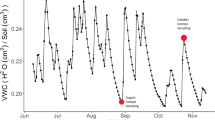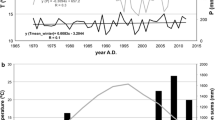Abstract
This study investigated seasonal variation in the origin of water used by plants in a riparian tropical rainforest community and explored linkages between plant water source, plant xylem hydraulic conductivity and response to the onset of dry conditions. The study focused on five co-dominant canopy species, comprising three tree species (Doryphora aromatica, Argyrodendron trifoliolatum, Castanospora alphandii) and two climbing palms (Calamus australis and Calamus caryotoides). Stable isotope ratios of oxygen in water (δ18O) from soil, groundwater, stream water and plant xylem measured in the wet season and the subsequent dry season revealed water resource partitioning between species in the dry season. Measurement of stem-area-specific hydraulic conductivity (K S) in the wet season and subsequent dry season showed a significant dry-season loss of K S in three of the five species (Castanospora alphandii, Calamus australis and C. caryotoides) and a decrease in mean K S for all species. This loss of hydraulic conductivity was positively correlated with the difference between wet-season and dry-season midday leaf water potentials and with leaf carbon isotope discrimination, indicating that plants that were less susceptible to loss of conductivity had greater control over transpiration rate and were more water-use efficient.









Similar content being viewed by others
References
Alstad KP, Welker JM, Williams SA, Trlica MJ (1999) Carbon and water relations of Salix monticola in response to winter browsing and changes in surface water hydrology: an isotopic study using δ13C and δ18O. Oecologia 120:375–385
Barbour MM, Farquhar GD (2000) Relative humidity and ABA-induced variation in carbon and oxygen isotope ratios of cotton leaves. Plant Cell Environ 23:473–485
Barnes CJ, Allison GB (1988) Tracing of water movement in the unsaturated zone using stable isotopes of hydrogen and oxygen. J Hydrol 100:143–177
Blake D (1972) Regional and economic geology of the Herberton/Mount Garnet Area—Herberton Tinfield, north Queensland. Bull Torrey Bot Club 124:60–64
Bleby TM, Aucote M, Kennet-Smith AK, Walker GR, Schachtman DP (1997) Seasonal water use characteristics of tall wheatgrass [Agropyron elongatum (Host) Beauv.] in a saline environment. Plant Cell Environ 20:1361–1371
Boutton TW, Archer SR, Midwood AJ (1999) Stable isotopes in ecosystem science: Structure, function and dynamics of a subtropical Savannah. Rapid Commun Mass Spectrom 13:1263–1277
Brodribb TJ, Feild TS (2000) Stem hydraulic supply is linked to leaf photosynthetic capacity: evidence from New Caledonian and Tasmanian rainforests. Plant Cell Environ 23:1381–1388
Caldwell MM (1987) Competition between roots in natural communities. In: Gregory PJ, Lake JV, Rose DA (eds) Root development and function. Cambridge University Press, New York
Caldwell MM, Richards JH (1986) Competing root systems: morphology and models of absorption. In: Givnish TJ (ed) On the economy of plant form and function. Cambridge University Press, New York, pp 251–274
Canadell J, Jackson RB, Ehleringer JR, Mooney HA, Sala OE, Schulze ED (1996) Maximum rooting depth of vegetation types at the global scale. Oecologia 108:583–595
Cavender-Bares J, Holbrook NM (2001) Hydraulic properties and freezing-induced cavitation in sympatric evergreen and deciduous oaks with contrasting habitats. Plant Cell Environ 24:1243–1256
Comstock JP (2000) Variation in hydraulic architecture and gas-exchange in two desert sub-shrubs, Hymenoclea salsola (T. & G.) and Ambrosia dumosa (Payne). Oecologia 125:1–10
Cook PG, Herczeg AL, McEwan KL (2001) Groundwater recharge and stream baseflow, Atherton Tablelands, Queensland. Technical report No 8. CSIRO Land and Water, Australia
Coplen TB (1988) Normalisation of oxygen and hydrogen isotope data. Chem Geol Isot Geo Sect 72:293–297
Cowan IR, Farquhar GD (1977) Stomatal function in relation to leaf metabolism and environment. Symp Soc Exp Biol 34:471–505
Dawson TE (1996) Determining water use by trees and forests from isotopic, energy balance and transpiration analyses—the roles of tree size and hydraulic lift. Tree Physiol 16:263–272
Dawson TE, Ehleringer JR (1991) Streamside trees that do not use stream water. Nature 350:335–337
Donovan LA, Grise DJ, West JB, Pappert RA, Alder NN, Richards JH (1999) Predawn disequilibrium between plant and soil water potentials in two cold-desert shrubs. Oecologia 120:209–217
Donovan LA, Linton MJ, Richards JH (2001) Predawn plant water potential does not necessarily equilibrate with soil water potential under well-watered conditions. Oecologia 129:328–335
Ehleringer JR, Philips SL, Schuster WFS, Sandquist DR (1991) Differential utilization of summer rains by desert plants: implications for competition and climate change. Oecologia 88:430–434
Farquhar GD, Richards RA (1984) Isotopic composition of plant carbon correlates with water-use efficiency of wheat genotypes. Aust J Plant Physiol 11:539–552
Farquhar GD, Ehleringer JR, Hubick KT (1989) Carbon isotope discrimination and photosynthesis. Annu Rev Plant Physiol Plant Mol Biol 40:503–537
Field TS, Dawson TE (1998) Water sources used by Didmopanax pittieri at different life stages in a tropical cloud forest. Ecology 79:1448–1452
Flanagan LB, Ehleringer JR, Marshall JD (1992) Differential uptake of summer precipitation and groundwater among co-occurring trees and shrubs in the southwestern United States. Plant Cell Environ 15:831–836
Franks PJ, Farquhar GD (1999) A relationship between humidity response, growth form and photosynthetic operating point in C3 plants. Plant Cell Environ 22:1337–1349
Gebauer RLE, Ehleringer EH (2000) Water and nitrogen uptake patterns following moisture pulses in a cold desert community. Ecology 81:1415
Goldstein G, et al (1998) Stem water storage and diurnal patterns of water use in tropical forest canopy trees. Plant Cell Environ 21:397–406
Gonfiantini R (1978) Standards for stable isotope measurement in natural compounds. Nature 271:534–536
Hendry MJ (1983) Groundwater recharge through a heavy-textured soil. J Hydrol 63:201–209
Jackson P, Cavalier J, Goldstein G (1995) Partitioning of water resources among plants of lowland tropical forest. Oecologia 101:197–203
Jones HG, Sutherland RA (1991) Stomatal control of xylem embolism. Plant Cell Environ 14:607–612
Kolb TE, Hart SC, Amundson R (1997) Boxelder water sources and physiology at perennial and ephemeral stream sites in Arizona. Tree Physiol 17:151–160
Laffan MD (1988) Soils and Land Use on the Atherton Tableland, North Queensland. Report No 61. CSIRO Division of Soils, Australia, pp 55–57
Lamont BB, Bergl SM (1991) Water relations, shoot and root architecture, and phenology of three co-occurring Banksia species: no evidence for niche differentiation in the pattern of water use. Oikos 60:291–298
Meinzer FC, Grantz DA (1990) Stomatal and hydraulic conductance in growing sugarcane: stomatal adjustments to water transport capacity. Plant Cell Environ 13:383–388
Meinzer FC, Andrade JL, Goldstein G, Holbrook NM, Cavelier J, Wright SJ (1999) Partitioning of soil water among canopy trees in a seasonally dry tropical forest. Oecologia 121:293–301
Panek JA (1996) Correlations between stable carbon-isotope abundance and hydraulic conductivity in Douglas-fir across a climate gradient in Oregon, USA. Tree Physiol 16:747–755
Patino S, Tyree MT, Herre EA (1995) Comparison of hydraulic architecture of woody plants of differing phylogeny and growth form with special reference to freestanding and hemi-epiphytic Ficus species from Panama. New Phytol 129:125–134
Prior LD, Eamus D, Duff GA (1997) Seasonal trends in carbon assimilation, stomatal conductance, pre-dawn leaf water potential and growth in Terminalia ferdinandiana, a deciduous tree of northern Australian savannas. Aust J Bot 45:53–69
Reich PB, Hinckley TM (1989) Influence of pre-dawn water potential and soil-to-leaf hydraulic conductance on maximum daily diffusive resistances in two oak species. Funct Ecol 3:719–726
Revesz K, Woods PH (1990) A method to extract water for stable isotope analysis. J Hydrol 115:397–406
Sperry JS, Pockman WT (1993) Limitation of transpiration by hydraulic conductance and xylem cavitation in Betula occidentalis. Plant Cell Environ 16:279–287
Stratton LC, Goldstein G, Meinzer FC (2000) Temporal and spatial partitioning of water resources among eight woody species in Hawaiian dry forest. Oecologia 124:309–317
Thorburn PJ, Walker GR (1994) Variation in stream water uptake by Eucalyptus camaldulensis with differing access to stream water. Oecologia 100:293–301
Thorburn PJ, Hutton TJ, Walker GR (1993a) Combining measurements of transpiration and stable isotopes of water to determine groundwater discharge from forests. J Hydrol 150:563–587
Thorburn PJ, Walker GR, Brunel JP (1993b) Extraction of water from Eucalyptus trees for analysis of deuterium and oxygen-18: Laboratory and field techniques. Plant Cell Environ 16:269–277
Tomlinson PB, Fisher JB, Spangler RE, Richer RA (2001) Stem vascular architecture in the rattan palm Calamus (Arecaceae-Calamoideae-Calaminae). Am J Bot 88:797–809
Tracey JG (1982) Vegetation of the humid tropical region of North Queensland. CSIRO, Melbourne
Tyree MT, Graham MED, Cooper KE, Bazos LJ (1983) The hydraulic architecture of Thuja occentalis. Can J Bot 61:2105–2111
Van Ieperen W, van Meeteren U, van Gelder H (2000) Fluid ionic composition influences hydraulic conductance of xylem conduits. J Exp Bot 51:769–776
Webb LJ (1956) Environmental studies in Australian rain forests. Dissertation. University of Queensland, Australia, Brisbane
Yang S, Tyree MT (1993) Hydraulic resistance in Acer saccharam shoots and its influence on leaf water potential and transpiration. Tree Physiol 12:231–242
Zwieniecki MA, Melcher PJ, Holbrook NM (2001) Hydrogel control of xylem hydraulic resistance in plants. Science 291:1059–1062
Acknowledgements
This work was supported by the Land and Water Resources Research and Development Corporation, Australia (LWRRDC) and by the Rainforest CRC. We gratefully acknowledge the assistance of G. Lukacs, G. Werren and R. and S. Ford.
Author information
Authors and Affiliations
Corresponding author
Rights and permissions
About this article
Cite this article
Drake, P.L., Franks, P.J. Water resource partitioning, stem xylem hydraulic properties, and plant water use strategies in a seasonally dry riparian tropical rainforest. Oecologia 137, 321–329 (2003). https://doi.org/10.1007/s00442-003-1352-y
Received:
Accepted:
Published:
Issue Date:
DOI: https://doi.org/10.1007/s00442-003-1352-y




